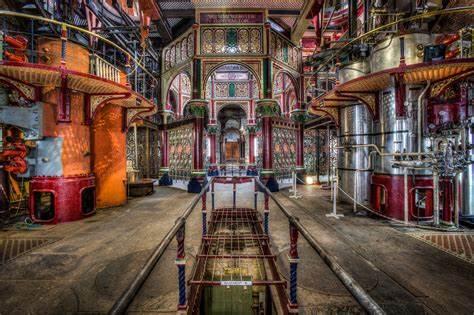TASKL Visit to Owlpen Manor Thursday 2nd May 2024
The Arts Society Welwyn Garden visit to Crossness Pumping Station
The Arts Society Welwyn Garden visit to Crossness Pumping Station
7 May 2023
On a chilly April morning members left Welwyn Garden City for south east London to visit Crossness Pumping Station. This has been described as one of the “Seven Wonders of the Industrial World” and it did not disappoint. It soon became apparent that we were witnessing the sheer brilliance of Victorian planning and engineering.
The River Thames had long been used as a means of disposing of London’s human waste but “the Big Stink” of 1858 prompted the government to take action. A rapidly growing population and increased outbreaks of cholera made it necessary to create a radical new way of dealing with ever increasing amounts of sewage.
Joseph Bazalgette was chief engineer of the Metropolitan Board of Works at the time and he designed a vast new underground sewer system for the city which is still in operation today. Crossness Pumping Station was a key element in Bazalgette’s planning to improve the health and sanitation of Victorian London, and such was the urgency that work started in 1859 and was completed by 1865. Amazing!
The sewers carried the sewage 14 miles east of London to the Erith marshes where the Crossness engines were built. Four huge beam engines were used to pump the sewage into a reservoir before it was discharged into the Thames on ebbing tides. However, a major disaster occurred in 1887 when a pleasure boat, The Princess Alice, returning upstream to London collided with a cargo boat, resulting in the loss of 650 lives. Those thrown into the river found themselves fighting to swim and breathing in raw sewage.
This tragedy resulted in the decision to stop discharging directly into the river and to divert the sewage to settling beds to dry out. The dry waste was then loaded and transported out to sea on “sludge vessels”. This system was still in use until recent times.
After the Second World War the Crossness engines had reached the end of their working life and the site was decommissioned in the 1950s. In 1987 the Crossness Engines Trust was formed to preserve the now listed buildings and return these unique pumping engines to their former glory.
About the Author
Dianne Howes
- Crossness visit
JOIN OUR MAILING LIST
Become an instant expert!
Find out more about the arts by becoming a Supporter of The Arts Society.
For just £20 a year you will receive invitations to exclusive member events and courses, special offers and concessions, our regular newsletter and our beautiful arts magazine, full of news, views, events and artist profiles.
FIND YOUR NEAREST SOCIETY
MORE FEATURES
The Arts Society South Cambs used their Community Grant to support musical workshops and concerts for pupils at neighbouring Sawston Village College giving 425 pupils a day they'll never forget!



